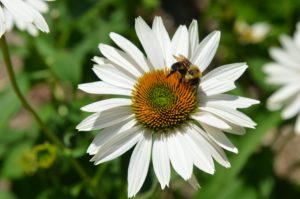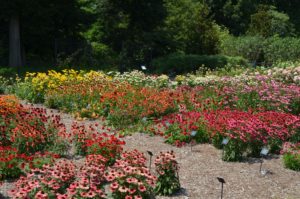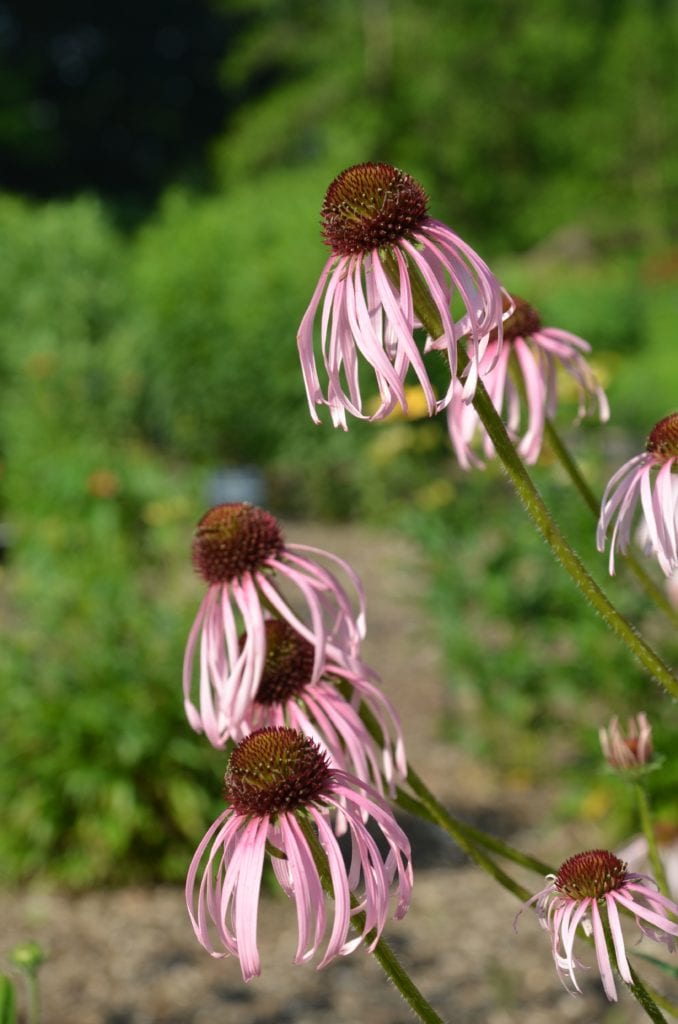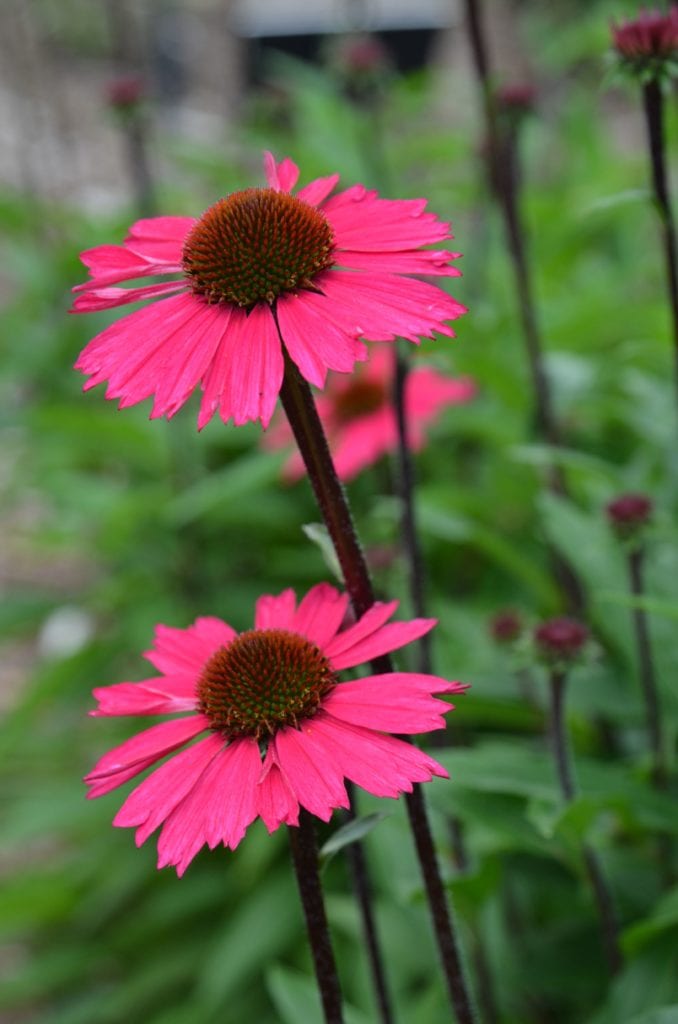By Sam Hoadley, Manager of Horticultural Research
Echinacea, commonly known as coneflowers, are some of the most iconic plants native to North America, with a long history in both traditional medicine and ornamental horticulture. Since the early 1990s, Echinacea has experienced a horticultural renaissance thanks to plant breeders’ hybridization work in the United States and Europe. In particular, the crossing of two or more of the nine species of coneflowers resulted in the flood of new Echinacea cultivars in the horticultural market. Today, coneflowers come in a broad spectrum of colors, including red, orange, yellow, pink, purple, white, and even green. Unique flower forms, including double or “pompom” flowers, add to this newfound diversity of coneflowers. While many of these plants look fantastic on paper, Mt. Cuba aimed to assess their actual garden performance and document their ability to attract insect pollinators.
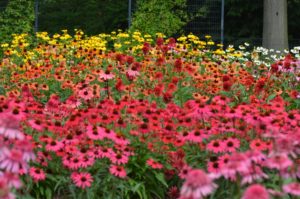
Echinacea Trial Gardens at Mt.Cuba Center Hockessin, DE
The trial, which spanned three years (2018-2020), included 75 different coneflower species and cultivars. Data was collected on physical attributes, horticultural appeal, disease resistance, and attractiveness to insect pollinators, with a particular focus on wasp, bee, and butterfly visitation. The following plants are a selection of Mt. Cuba’s top-rated coneflower cultivars based on these results. Detailed information on every coneflower included in our trial and a downloadable research report are available on our website: Echinacea for the Mid-Atlantic Region – Mt. Cuba Center.
Echinacea purpurea ‘Pica Bella’
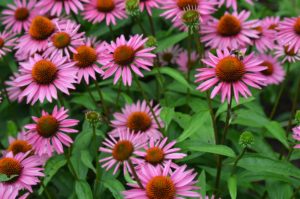
Echinacea purpurea ‘Pica Bella’
Before we crunched any numbers at the beginning of this coneflower trial, we knew Echinacea purpurea ‘Pica Bella’ was a special plant. This semi-compact cultivar of Echinacea purpurea received top-notch ratings in our first Echinacea trial conducted from 2007-2009. Still, we were excited to see how well ‘Pica Bella’ continued to perform almost a decade later. It stood out thanks to its remarkable vigor, consistency, and showstopping floral display. In addition to its obvious ornamental qualities, we were also excited to find that ‘Pica Bella’ was popular with insect pollinators as well. In 2018-2019 a talented group of volunteer citizen scientists dubbed the Pollinator Watch team monitored each blooming coneflower cultivar for 60 seconds and counted how many bees, wasps, and butterflies visited that plant. Their data showed that ‘Pica Bella’ placed in the top 15 coneflowers for insect attraction, making it an easy choice for gardeners who want a beautiful plant that also attracts pollinators. Similar coneflowers for garden use include the widely available Echinacea purpurea ‘Ruby Star’ and the straight species Echinacea purpurea. Echinacea purpurea ‘Pica Bella’ – Mt. Cuba Center
Echinacea purpurea ‘Fragrant Angel’
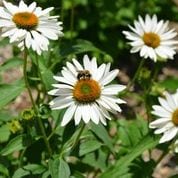
Echinacea purpurea ‘Fragrant Angel’
Echinacea purpurea ‘Fragrant Angel’ was another top performer from our first trial that scored well in our latest coneflower evaluation. Besides its slightly compact nature and white flowers, ‘Fragrant Angel’ is very similar to its parent species. In addition to being one of the top-rated white blooming coneflowers in the trial, ‘Fragrant Angel’ attracted the most insect pollinators of any plant in the trial (The straight species Echinacea purpurea came in a close second). A notable finding was that ‘Fragrant Angel’ also attracted the most butterflies of any Echinacea that we evaluated. Overall, butterflies made up only five percent of the insect pollinators in the trial, while bees and wasps accounted for the remainder of recorded visits. In fact, most coneflowers in the trial averaged only two butterfly visits over the pollinator study duration, but ‘Fragrant Angel’ averaged nearly a dozen. There are many plant-related factors that attract pollinators, and these were not specifically investigated. It was clear that butterflies found this cultivar, above all others, the most attractive. Other excellent white-blooming coneflowers include Echinacea ‘Balsomblanc’ (SOMBRERO® Blanco), Echinacea purpurea ‘Baby Swan White,’ Echinacea purpurea ‘PAS702918’ (PowWow® White), and Echinacea ‘Snow Cone.’ Echinacea purpurea ‘Fragrant Angel’ – Mt. Cuba Center
Echinacea ‘Santa Fe’
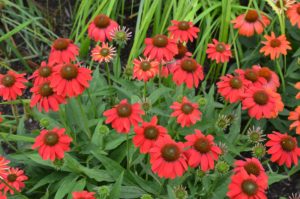
Echinacea ‘Santa Fe
Several red to orange-flowered cultivars made the top performer list, but Echinacea ‘Santa Fe’, also known as Echinacea Lakota™ Fire, was horticulturally the best. This seed cultivar was vigorous and uniform and contributed a fiery floral display in the trial gardens from late June through late July. This riot of color caught our guests’ attention, who voted it among their top five favorites in both 2018 and 2019. Other excellent orange and red-flowered cultivars included Echinacea ‘POST301’ (Postman), Echinacea ‘TNECHKIO’ (KISMET® Intense Orange), Echinacea ‘Balsomcor’ (SOMBRERO® Hot Coral), Echinacea ‘Julia,’ and Echinacea ‘Balsomenco’ (SOMBRERO® Flamenco Orange). Echinacea ‘Santa Fe’ – Mt. Cuba Center
Echinacea ‘Sensation Pink’
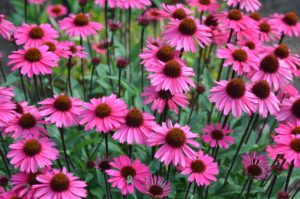
Echinacea ‘Sensation Pink’
Echinacea ‘Sensation Pink’ was one of the most striking plants in the entire trial. The glowing neon pink petals of its flowers have an otherworldly look to them and almost appeared to glow in the right light. Another sensational feature of this cultivar was its unique dark floral stems that provided a highly ornamental backdrop to the luminous blooms. This cultivar was also the fifth most visited coneflower in the trial by pollinating insects. The top-performing Echinacea ‘Glowing Dream’ behaved very similarly to ‘Sensation Pink’ but lacked its signature dark stems. Other excellent pink-flowered Echinacea hybrids include Echinacea ‘TNECHKR’ (KISMET® Raspberry) and Echinacea ‘Purple Emperor. Echinacea ‘Sensation Pink’ – Mt. Cuba Center
Echinacea species were also an important component of our trial. The species that were tried were not top performers compared to cultivars, they can still be excellent garden plants in more specialized conditions. Be sure to check out pages 14 and 15 of the Echinacea Research Report for more information.
- Echinacea purpurea ‘Fragrant Angel’
- Echinacea Trial Garden
*Since 2002, trials at Mt. Cuba Center have provided gardeners, nurseries, and professional horticulturists with information on native plants that perform best in gardens of the mid-Atlantic. Subjects of past trials include asters, Echinacea, Heuchera, Coreopsis, Baptisia, Monarda, Phlox, Helenium. These trial Reports can be found on Mt. Cuba Center’s website: Trial Garden – Mt. Cuba Center
- Echinacea pallida
- Echinacea ‘Sensation Pink’
About the Author
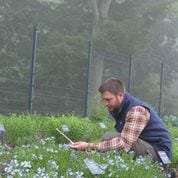
Sam Hoadley is the Horticultural Research Manager at Mt. Cuba Center. His work includes evaluating native plants in Mt Cuba’s Trial Garden to determine their horticultural and ecological values. Current genera on trial include Hydrangea arborescens, Carex, Vernonia, and Solidago. Sam received his degree in Sustainable Landscape Horticulture from The University of Vermont.
***
Each author appearing herein retains original copyright. Right to reproduce or disseminate all material herein, including to Columbia University Library’s CAUSEWAY Project, is otherwise reserved by ELA. Please contact ELA for permission to reprint.
Mention of products is not intended to constitute endorsement. Opinions expressed in this newsletter article do not necessarily represent those of ELA’s directors, staff, or members.

